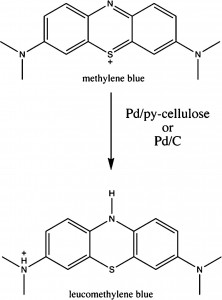During January, many people will be attempting to ‘de-tox’ – to get rid of the feeling of all those unpleasant residues lingering in the body from the holiday season’s excesses.
 Back in the world of chemistry, it is just as important (and considerably simpler!) to ‘de-tox’. You don’t need a diet guru – you just need some clever catalysts. Waste water treatment is one example of an area where chemists are applying their skills to remove organic contaminants (such as light-stable dyes used in the textile industry) from effluent that will be released into the environment.
Back in the world of chemistry, it is just as important (and considerably simpler!) to ‘de-tox’. You don’t need a diet guru – you just need some clever catalysts. Waste water treatment is one example of an area where chemists are applying their skills to remove organic contaminants (such as light-stable dyes used in the textile industry) from effluent that will be released into the environment.
For example, a project by the U.S. Environmental Protection Agency, along with collaborators at Texas A&M University and The University of Texas at Dallas, both in the USA, has been working on a new approach to create gold, palladium and platinum nanocrystals decorated on biodegradable cellulose polymer coated with polypyrrole. Their Pd-decorated fibre materials could catalyse the degradation/reduction of methylene blue (a waste water simulator) to leucomethylene blue at room temperature in aqueous media.
The authors claim that their technique can reduce the amount of nondegradable polymer (polypyrrole) by at least 80%, and that the same type of particles may be suitable for application in sensors, fuel cells, medical devices and other technologies.
To find out more, read about the work in RSC Advances – access this article for free!
Novel Pd based catalyst for the removal of organic and emerging contaminants, Mallikarjuna N. Nadagouda, Ishan Desai, Carlo Cruz and Duck J. Yang, RSC Adv., 2012, 2, 7540–7548
Stay up-to-date with the latest content in RSC Advances by registering for our free table of contents alerts.
By Sara Coles










